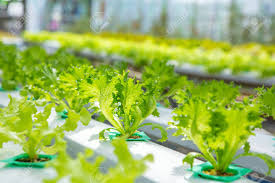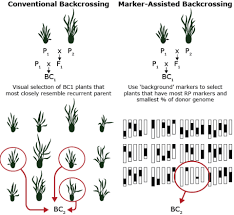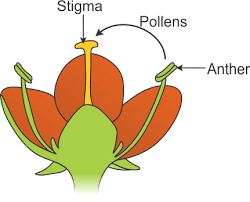Mass selection refers to the process of selecting a large number of plants with similar phenotypes and mixing their seeds together to create a new variety. In phenotypic mass selection, selection can be based on qualitative traits, such as flower color or disease resistance, or quantitative traits like height, earliness, and seed yield.
Qualitative Traits and Quantitative Traits in Mass Selection
Qualitative traits are governed by major genes, often only a few genes, which significantly influence the plant’s appearance. These traits are not influenced by the environment, and their inheritance is predictable in breeding.
For example, in cowpea, these genes control characteristics like leaf shape, flower and seed color patterns, and resistance to common diseases and pests.
In contrast, quantitative traits are controlled by multiple minor or polygenes, where many genes are involved. These traits are affected by environmental factors and are typically linked to economic traits, such as seed yield and milk yield.
Timing of Selection in Mass Selection
The timing of selection during plant development plays a significant role in the effectiveness of mass selection. If selections are made before flowering, unwanted plants can be removed from the population, and only selected plants will mate, passing their genes to the next generation.
If selection is made after flowering, selected plants may have crossed with all plants in the population, introducing genes from unwanted plants.
For cross-pollinated crops, inbreeding must be avoided, as it can result in the loss of vigor and yield. Mass selection can be employed both to maintain existing varieties and to develop new ones.
Read Also: Prevention and Methods of Controlling Coccidiosis Among Chickens
Mass Selection Process in Cross Pollinated Crops

Mass selection, which involves selecting a large number of plants with similar phenotypes and mixing their seeds, is used to create a new variety.
The population resulting from the selected plants will be more uniform than the original population.
Methodology for Phenotypic Mass Selection
In phenotypic mass selection, a large number of individual plants are selected based on superior phenotype. Selection is often done on maternal parents since pollen control is not feasible. An example is selecting maize ears based on characteristics.
- Mix the seeds of the selected plants without progeny testing.
- The mixed seeds are planted together to produce the next generation.
- This process continues until the desired level of uniformity is achieved.
Mass Selection Process: Year-by-Year Overview
Year 1 (C0 – Source Population):
The base population is the starting point for mass selection.
Year 2 (C1 – Improved Population):
The improved population is formed by continuing the selection process. The process is repeated to ensure further improvement.
Read Also: Time and Methods of Fertilizer Application on Crops
Methodology for Mass Selection with a Progeny Test

- Select Similar and Superior Phenotypes: Plants are selected from the base population, with seeds from individual plants kept separately.
- Plant the Seeds from Individual Plants in Rows: The harvested seeds are planted in equal number of rows.
- Reject Inferior or Segregating Progenies: Remove inferior progenies, and only superior progeny seeds are kept.
- Harvest Seeds from Superior Progenies: The seeds from the remaining superior progenies are harvested together.
- Plant Bulk Seeds from Superior Progenies in Isolation: The bulk seeds are isolated and planted to maintain purity.
- Select Superior Phenotypes for New Varieties: The selected superior phenotypes are developed into new varieties.
This process may be repeated every few years to maintain the purity of the variety as necessary.
Mass Selection with a Progeny Test: Year-by-Year Overview
- Year 1 (Source Population): Select similar and superior phenotypes (200-1000 plants). Seeds from individual plants are harvested separately.
- Year 2 (Planting of Individual Seeds): Plant the harvested seeds from individual plants in rows. Inferior progenies are rejected. Seeds from superior plants are harvested together.
- Year 3 (Preliminary Yield Trials): The composite or bulk seeds are used for yield trials, alongside standard checks (varieties already adapted and accepted in the community).
- Years 4-7 (Multilocation Coordinated Yield Trials): Conduct trials in multiple locations to further evaluate the performance.
- Year 8 (Release of New Varieties): Superior phenotypes are released as new varieties. Seeds are multiplied and distributed.
Ear-to-Row Selection in Cross Pollinated Crops
Ear-to-row selection is a technique used to improve intrapopulation characteristics. It involves selecting several good maize ears and evaluating them using a progeny test.
This method was a modification of mass selection and involves planting seeds from each ear in separate rows, evaluating the rows for yielding ability, and selecting the most productive ones. The technique was used by Hopkins (1897) to improve maize seed oil and protein content over time.
Procedure for Ear-to-Row Selection: Year-by-Year Overview
- Year 1 (Selection of Maize Ears):
Select 50-100 maize ears from the source population (open-pollinated). The seeds from each ear are shelled separately. - Year 2 (Ear-to-Row Planting):
Plant part of the seeds from each ear as ear-to-row. The remainder is labeled and stored. Each row is evaluated for desirable traits and yield, and the best rows are selected. - Year 3 (Replanting Superior Progenies):
Replant seeds from the remnant of ears that gave superior progenies in the second year.
Response to Mass Selection in Self and Cross Pollinated Crops
Both self-pollinated and cross-pollinated crops respond to mass selection. However, self-pollinated crops will produce more uniform progeny, while cross-pollinated crops will show more variation due to genetic diversity.
Do you have any questions, suggestions, or contributions? If so, please feel free to use the comment box below to share your thoughts. We also encourage you to kindly share this information with others who might benefit from it. Since we can’t reach everyone at once, we truly appreciate your help in spreading the word. Thank you so much for your support and for sharing!

